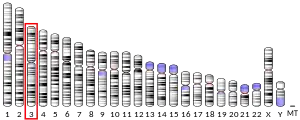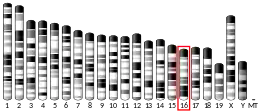C3orf70
C3orf70 also known as Chromosome 3 Open Reading Frame 70, is a 250aa protein in humans that is encoded by the C3orf70 gene. The protein encoded is predicted to be a nuclear protein; however, its exact function is currently unknown.[1] C3orf70 can be identified with known aliases: Chromosome 3 Open Reading Frame 70, AK091454, UPF0524, and LOC285382.[1][2]
| C3orf70 | |||||||||||||||||||||||||||||||||||||||||||||||||||
|---|---|---|---|---|---|---|---|---|---|---|---|---|---|---|---|---|---|---|---|---|---|---|---|---|---|---|---|---|---|---|---|---|---|---|---|---|---|---|---|---|---|---|---|---|---|---|---|---|---|---|---|
| Identifiers | |||||||||||||||||||||||||||||||||||||||||||||||||||
| Aliases | C3orf70, chromosome 3 open reading frame 70 | ||||||||||||||||||||||||||||||||||||||||||||||||||
| External IDs | MGI: 1919440 HomoloGene: 78167 GeneCards: C3orf70 | ||||||||||||||||||||||||||||||||||||||||||||||||||
| |||||||||||||||||||||||||||||||||||||||||||||||||||
| |||||||||||||||||||||||||||||||||||||||||||||||||||
| |||||||||||||||||||||||||||||||||||||||||||||||||||
| |||||||||||||||||||||||||||||||||||||||||||||||||||
| Wikidata | |||||||||||||||||||||||||||||||||||||||||||||||||||
| |||||||||||||||||||||||||||||||||||||||||||||||||||
Gene
In humans, C3orf70 is located on the reverse strand of Chromosome 3 at 3q27.2 (see Figure 1).[7] This identifies its location starting 184,795,838 base pairs and ending 184,870,802 base pairs from PTER, the terminus of the short arm, on chromosome 3. C3orf70 spans 74,964 bases containing two exons and two introns.
mRNA
The transcribed mRNA is a 5,901 base pair transcript. C3orf70 consists of one known splice variant with two exons of 388 base pairs and 5,512 base pairs respectively (see Figure 2); location of junction occurs at 67aa[C].[1] A single 5’ cap and three possible 3’ polyadenylation signals have been identified.[1]
Protein
Composition
The translated protein is a 250 amino acid product. The precursor protein has been predicted with a molecular weight of 27.8kdal and an isoelectric point of 4.67.[8] With 33 serines and 8 glycines, the C3orf70 protein is both Serine rich and Glycine poor.[8]
Domains
C3orf70 protein has no known signal peptides or domains.
Homology
C3orf70 has no known paralogs in humans; however C3orf70 has conserved homologs, see Figure 3. Highly conserved across species excluding invertebrates, plants, fungi, and bacteria, C3orf70 shows a moderate rate of evolution, see Figure 4 and 5.[9]
 Figure 3: Compiled data for select orthologs of C3orf70 across species
Figure 3: Compiled data for select orthologs of C3orf70 across species Figure 4: C3orf70 Homolog Protein Divergence from Homo sapiens. Color identification specific to species (shown in Figure 3). Time of divergence calculated by timetree.org. Non-identity calculated based on (1-NCBI sequence identity).
Figure 4: C3orf70 Homolog Protein Divergence from Homo sapiens. Color identification specific to species (shown in Figure 3). Time of divergence calculated by timetree.org. Non-identity calculated based on (1-NCBI sequence identity). Figure 5: Divergence rate of C3orf70 with respect to Cytochrome C and Fibrinogen displaying a moderate to slow rate of divergence.
Figure 5: Divergence rate of C3orf70 with respect to Cytochrome C and Fibrinogen displaying a moderate to slow rate of divergence.
Regulation
Promoter
There is only one known promoter predicted by Genomatix for the C3orf70 protein located on the minus strand of chromosome 3 at location 184870702-184871302bp, therefore identified as 600bp in length.[10] High mammalian conservation was observed for the identified promoter sequence.
Transcription factors

Through the use of Genomatix, a table was generated of the top 20 transcription factors and their binding sites in the C3orf70 promoter (see Figure 6).[10]
Post-translational modifications
Utilizing NetPhos, a total of 25 phosphorylation sites have been predicted (20 Serines, 3 Threonines, and 2 Tyrosines) which occur throughout the protein indicating an intracellular localization.[11] Figure 7 pinpoints the location of the 25 potential phosphorylation sites. Additionally, two N-myrisolation sites were predicted at amino acid position 40-45 and 210-215 indicating a possible N-terminus and C-terminus membrane anchor region.[12] There are also 28 potential missense mutations in the human C3orf70.[13]
Subcellular localization
PSORT II indicates the subcellular localization of C3orf70 is in the nucleus.[14] In addition to this, following SDSC's Biology Workbench's SAPS kNN-Prediction, the C3orf70 protein for humans has a 60.9% likelihood to end up in the nuclear region of a cell, as determined by the amino acid make-up of C3orf70.[8] Homologs including chimp, mouse, alligator, and zebrafish conclude the same nuclear region with a >60% likelihood.[14] A nuclear localization site has not been identified in the C3orf70 sequence.
Expression
From Unigene's EST cDNA tissue abundance display (see Figure 8), C3orf70 is non-ubiquitously expressed and has relatively low expression levels with slightly higher expression levels seen in the brain.[15] Also, microarray data profile GDS426 (see Figure 9) showing the expression of C3orf70 across normal tissues displays a notably high presence in the brain, spinal cord, and prostate tissue.[16]
Function and further reading
The function of C3orf70 is unknown. It is suggested to be a nuclear protein that plays a role in neurological development. Additional avenues of research pertaining to the C3orf70 gene include:
There is a patent that identified genes associated with midbrain dopamine neurons for engraftment by looking at the differentiation of hESC and/or hiPSC in floor plate midbrain progenitor cells. C3orf70 was found to have a fold-change of 2.45, which was not determined significant in experimentation [17]
A publication was discovered through multiple sources that linked the C3orf70 gene to a “Genome-wide association study of major depressive disorder”.[18]
A microdeletion has been identified from 3q26.33-3q27.2.[19] Mandrille et al. associates this discovered microdeletion with a possible clinical syndrome characterized by clinical features related to brain development.
References
- NCBI AceView. "Homo sapiens gene C3orf70, encoding chromosome 3 open reading frame 70". Retrieved 2015-04-10.
- NCBI. "C3orf70 chromosome 3 open reading frame 70 [ Homo sapiens (human) ]". Retrieved 2015-04-10.
- GRCh38: Ensembl release 89: ENSG00000187068 - Ensembl, May 2017
- GRCm38: Ensembl release 89: ENSMUSG00000043391 - Ensembl, May 2017
- "Human PubMed Reference:". National Center for Biotechnology Information, U.S. National Library of Medicine.
- "Mouse PubMed Reference:". National Center for Biotechnology Information, U.S. National Library of Medicine.
- "NCBI C3orf70 protein". Conserved Domain Database. National Center for Biotechnology Information. Retrieved 2015-04-18.
- Department of Bioengineering. "SDSC Biology Workbench". University of California, San Diego. Retrieved 2015-04-18.
- "BLAST: Basic Local Alignment Search Tool". Conserved Domain Database. National Center for Biotechnology Information. Retrieved 2015-04-18.
- Genomatix Software. "Genomatix ElDorado". Retrieved 2015-04-18.
- Blom, N.; Gammeltoft, S.; Brunak, S. (1999). "Sequence- and structure-based prediction of eukaryotic protein phosphorylation sites". Journal of Molecular Biology. 294 (5): 1351–62. doi:10.1006/jmbi.1999.3310. PMID 10600390. Retrieved 2015-04-19.
- Sigrist CJ, Cerutti L, de Castro E, Langendijk-Genevaux PS, Bulliard V, Bairoch A, Hulo N. "a protein domain database for functional characterization and annotation". Nucleic Acids Res. Retrieved 2015-04-19.
- "dbSNP". Conserved Domain Database. National Center for Biotechnology Information. Retrieved 2015-03-11.
- Paul Horton. "PSORT II". Psort.hgc.jp. Retrieved 2015-04-19.
- "Unigene". Conserved Domain Database. National Center for Biotechnology Information. Retrieved 2015-04-19.
- "C3orf70 –Normal human tissue expression profiling". NCBI GEO Profile. National Center for Biotechnology Information. Retrieved 2015-04-19.
- Lorenz Studer; Jae-won Shim; Sonja Kriks. "Midbrain Dopamine (DA) Neurons for Engraftment". Retrieved 2015-04-18.
- Wray NR, Pergadia ML, Blackwood DH, Penninx BW, Gordon SD, Nyholt DR, Ripke S, MacIntyre DJ, McGhee KA, Maclean AW, Smit JH, Hottenga JJ, Willemsen G, Middeldorp CM, de Geus EJ, Lewis CM, McGuffin P, Hickie IB, van den Oord EJ, Liu JZ, Macgregor S, McEvoy BP, Byrne EM, Medland SE, Statham DJ, Henders AK, Heath AC, Montgomery GW, Martin NG, Boomsma DI, Madden PA, Sullivan PF (2012). "Genome-wide association study of major depressive disorder: new results, meta-analysis, and lessons learned" (PDF). Mol Psychiatry. Molecular Psychiatry. 17 (1): 36–48. doi:10.1038/mp.2010.109. PMC 3252611. PMID 21042317.
- Mandrile G, Dubois A, Hoffman JD, Uliana V, Di Maria E, Malacarne M, Coviello D, Faravelli F, Zwolinski S, Hellens S, Wright M, Forzano F (2014). "3q26.33-3q27.2 microdeletion: A new microdeletion syndrome?". Eur J Med Genet. European Journal of Medical Genetics. 57 (2–3): 76–80. doi:10.1016/j.ejmg.2013.12.007. PMID 24462885.
External links
- Human C3orf70 genome location and C3orf70 gene details page in the UCSC Genome Browser.



